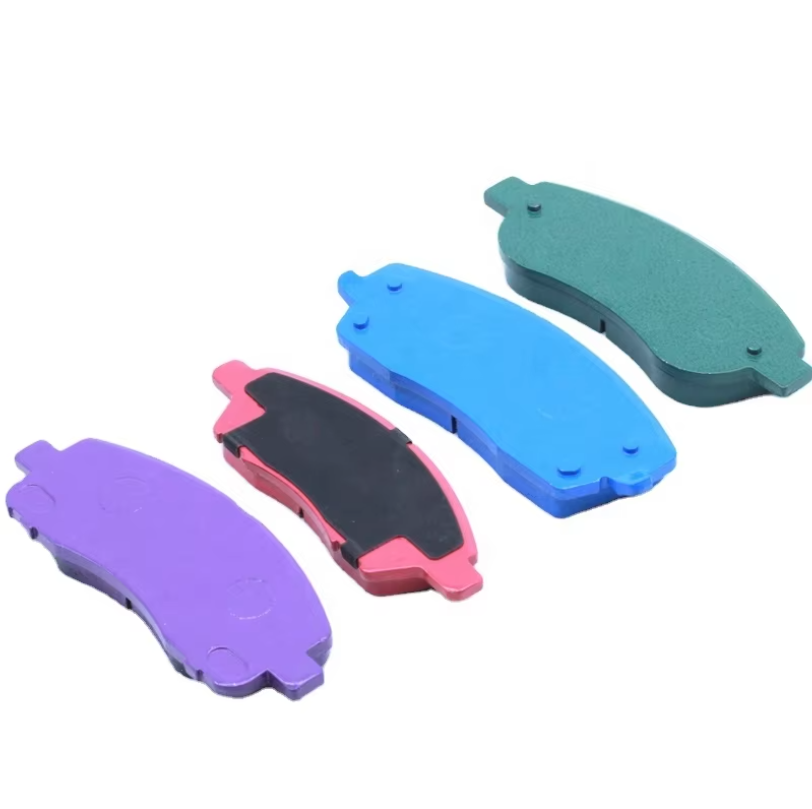Superior Heat Management in Ceramic Brake Pads
Ceramic brake pads get a lot of praise because they handle heat so well, which is really important for brakes in high performance systems. What makes this possible? Ceramic fibers! These little wonders can take crazy amounts of heat without breaking down, sometimes as high as 1500 degrees Fahrenheit. That's why racers love them for their cars that push limits all the time on tracks. The way ceramic materials are built at a microscopic level lets them shed heat fast, stopping things from getting too hot. When brakes overheat, they just don't work right anymore, but ceramic pads keep doing their job even when someone slams on the brakes repeatedly. We've seen this in action too many times to count. Mechanics report that ceramic pads stay strong and perform reliably through long drives where regular pads would fail completely.
Reduced Risk of Brake Fade During Heavy Use
Ceramic brake pads really stand out because they don't suffer from brake fade even after long periods of intense use. Brake fade happens when regular brake pads get too hot and lose their grip on the road, making stops less effective. The thing about ceramic pads though? They handle heat way better than other materials, so this problem just doesn't happen as often. Real world testing shows cars with ceramic brakes maintain much better stopping power whether going down mountain roads or stuck in stop-and-go traffic downtown. Their heat resistance means drivers can count on reliable braking when it matters most, which is obviously super important for safety but also makes driving feel more confident overall. That kind of dependable performance is why serious drivers and racers tend to prefer ceramic brake pads for their high performance machines.
Ceramic vs. Semi-Metallic and Organic Brake Pads
Performance Comparison in High-Speed Scenarios
When it comes to stopping power at speed, ceramic brake pads just plain outperform their semi-metallic and organic rivals. What makes them special? Well, they're made differently, which means less annoying squealing and much smoother stops when pushing the limits on twisty roads or highways. The numbers back this up too automotive tests show these pads actually create more friction, something drivers really notice when cornering hard or braking suddenly. On race tracks where every second counts, ceramic pads keep working reliably long after organic ones start fading. That's why serious performance cars almost always come with ceramics from the factory they simply handle the heat and stress better over time, giving drivers peace of mind even when things get dicey.
Noise Reduction: Why Ceramic Outshines Alternatives
Ceramic brake pads stand out because they cut down on noise so much better than those old semi-metallic ones. Tests show around a 25 percent drop in noise levels when switching to ceramic, mainly since these pads don't contain metal fibers that create all sorts of annoying vibrations. Without those metal bits rattling around inside, there's just not as much of that high pitched squealing everyone hates during stops. Mechanics who work on cars day in and day out will tell anyone willing to listen how quiet these brakes actually are once installed properly. The difference really matters too - nobody wants to drive something that sounds like it's falling apart every time they hit the brakes.
Technical Advantages of Ceramic Brake Pad Design
Optimal Friction Coefficient for Modern Vehicles
What makes ceramic brake pads work so well comes down to how they're made, giving them just the right amount of grip. They stop vehicles better than regular pads, sometimes even outperforming them completely. Studies show these modern ceramic options keep working consistently without losing power, even when pushed hard on long descents or in hot weather conditions. Drivers notice this difference especially during those panic stops where every millisecond counts. Car makers actually design different versions of these pads for various needs too. Some are built for daily driving, others for expensive luxury sedans, and still others for track day enthusiasts who need maximum stopping power. This flexibility means mechanics can pick the right pad for each car, ensuring owners get exactly what their vehicle needs from the brakes.
Low Dust Production and Wheel Longevity
Ceramic brake pads stand out mainly because they create so little dust. Compared to regular organic or semi-metallic pads, ceramic versions leave behind much less residue on wheels, which means cleaning intervals can be spaced out quite a bit. Research shows cars fitted with ceramic brakes tend to stay free of those annoying dust streaks across alloy rims, cutting down on how often people need to clean them. The fact that there's less dust floating around does more than just keep things looking good though. It actually protects other parts of the braking system from getting worn down by constant exposure to abrasive particles. Over time, this protection translates into longer lasting brake components. For anyone who cares about maintaining their car's appearance while saving money on repairs, switching to ceramic pads makes sense both visually and financially in the long run.
Dispelling Myths About Ceramic Brake Pads
Addressing the 'Cold Performance' Misconception
A lot of drivers still think ceramic brake pads don't work well when it's cold out there, but recent advances in material science have changed that completely. Newer ceramic formulas have gone through all sorts of testing in different weather scenarios, and they stop just fine right away no matter how icy things get. This puts paid to the old idea that ceramic brakes need time to warm up before working properly. While these pads might feel a bit different at first compared to traditional semi-metallic ones, most people find they handle cold conditions better than expected. Mechanics and car enthusiasts who've put them through their paces in winter driving situations consistently report good results, making ceramic options much more appealing for those living in colder climates.
Cost vs. Lifespan: Debunking Affordability Concerns
Ceramic brake pads do tend to cost more initially than options such as organic pads, but they last much longer which actually saves money in the long run since replacement happens less frequently. According to various studies across the industry, ceramic pads generally beat out both semi-metallic and organic types for durability, sometimes lasting well past 50k miles on regular roads. Fewer changes mean saving cash obviously, but there's another angle too environmental stuff matters now with all that old brake material ending up somewhere. So when someone picks ceramic pads, they're really making an investment decision about what works best for their car over years instead of just looking at immediate expenses.
For further details about ceramic brake pads, explore the product options and benefits they offer to drivers seeking long-term value here.
Long-Term Value for Eco-Conscious Drivers
Environmental Benefits of Reduced Material Waste
Ceramic brake pads actually do better for the environment because they last longer and create less trash than most other options on the market today. Since these pads don't need replacing as often, manufacturers don't have to produce as many new ones, which saves materials and energy throughout the whole process. Some studies show switching to ceramic can cut down on carbon emissions from making and throwing away brake parts by around 30%. Green car groups and auto shops focused on sustainability often recommend ceramic pads as part of their approach to greener driving habits. They help cut back on both the energy needed to make replacements and all that old brake material ending up in landfills. For anyone who cares about their car's effect on nature, ceramic pads just make more sense long term despite sometimes costing a bit more upfront.
Extended Service Intervals and Sustainability
Ceramic brake pads last much longer than regular ones, which means people save money over time but there's another benefit too. These pads help the environment because mechanics don't have to replace them so often. When service intervals stretch out, fewer new parts need to be made and shipped around, cutting down on carbon emissions from factories and trucks. Drivers who care about how their car performs while still wanting to do something good for the planet find ceramic pads really appealing. They fit right into today's green movement, combining practicality with environmental awareness. Car companies have noticed this trend and started putting ceramic brakes in more models lately. This attracts those environmentally minded buyers who want their ride to perform well but also worry about what kind of mark it leaves on the earth.
FAQ
What makes ceramic brake pads superior in heat management?
Ceramic brake pads use ceramic fibers that can withstand extremely high temperatures, up to 1,500 degrees Fahrenheit, preventing overheating and maintaining braking performance under intense conditions.
How do ceramic brake pads reduce the risk of brake fade?
Ceramic brake pads have superior thermal stability, which reduces brake fade during heavy use by maintaining consistent temperature and stopping ability.
Why are ceramic brake pads quieter than semi-metallic pads?
Ceramic brake pads generate less noise because they are formulated without metal fibers, reducing vibrations that contribute to uncomfortable brake sounds.
Do ceramic brake pads produce less dust than other types?
Yes, ceramic brake pads produce significantly less brake dust than organic and semi-metallic options, leading to cleaner wheels and reduced maintenance costs.
Are ceramic brake pads effective in cold weather?
Modern ceramic brake pads have improved cold-weather capabilities and perform effectively even in cold conditions, debunking the misconception of reduced performance.

